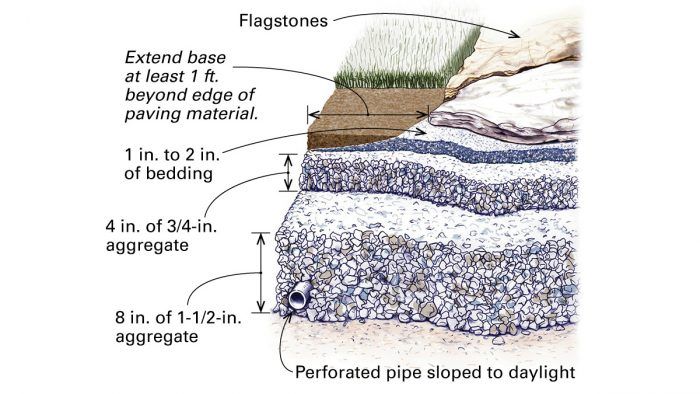Getting Patio Bases Right
Provide a stable base of permeable gravel to allow drainage and prevent heaving.

I’m planning to build a flagstone patio this spring. I’ve been told the most important step is preparing the base correctly. Do you have any tips for doing that work?
—Anita via email
Brian Post, a stoneworker and landscape architect from Chester, Vt., replies: The goal of a patio foundation is to provide a stable base that won’t settle or heave. Settling occurs from poor compaction or erosion. Heaving is caused by freezing water and tree roots. Drainage and compaction are the keys to avoiding those things and ensuring a patio’s (or a stone walk’s) longevity.
Using clear (also called “clean”) crushed stone for the lower layers is key to a solid foundation. Avoid using rounded stone—crushed stone should be angular and jagged so the pieces lock together. Don’t use a material with fines (this includes sure-pack, crusher run, plant mix, and quarry process ). The fines prevent drainage.
Every layer of a patio’s foundation needs to be thoroughly compacted. It’s best to use a jumping-jack-style compactor because its action reaches about 9 in. deep. A plate compactor can also work, but you need to work in much thinner lifts of material, about 2 in. at a time. Compacting by hand or driving a loaded pickup or earth-moving machine back and forth also works, but again, only with shallower lifts. Compactors can be had at nearly any rental yard.
The first step is digging down to about 16 in. below finish grade. (This can be reduced in areas with hard soil and no ground frost.) Prepare the foundation at least 1 ft. beyond each patio edge and compact the subsoil thoroughly. In poorly draining soil (such as clay or fine silt) or if water concentrates at the patio site, such as from a roof or because of runoff, pitch the subgrade 1/4 in. per ft. to a perforated collector pipe that slopes to daylight. In erodible soil such as sand, loam, or silt, lay down a layer of filter fabric to prevent soil eroding into the voids in the aggregate.
Begin filling the foundation with clean crushed aggregate. Compact in lifts sized to the ability of the compactor you are using. I like to use 1-1/2-in. aggerate for the first 8 in. or so, followed by 3/4-in. aggregate for the top 4 in. The smaller stone is easier to level by hand. Smooth and compact the top of the aggregate at 1 in. below the bottom of the thickest flagstone you’re using.
The flagstone is set in 1 in. to 2 in. of bedding material, which also fills the joints between stones. For larger flagstone, 3/8-in. clean pea gravel or chip stone creates a great, free-draining bedding. For flagstone averaging under 1-1/2 sq. ft., though, using 3/8-in. bedding can allow some movement underfoot. This isn’t a structural issue, but some people don’t like it. An alternative is to bed smaller flagstones in 3/8-in. sure-pack, which is a mixture of 3/8-in. and smaller stones and fines. This will pack hard and let very little water through. If you’re using sure-pack, place filter fabric under the bedding so the fines can’t fall into and clog the coarser aggregate below. Smooth and compact the bedding and you’re ready to begin laying flagstones.
Drawing: Michael Gellatly
From Fine Homebuilding #298
Related Link:





